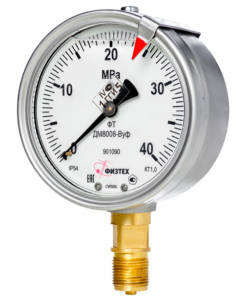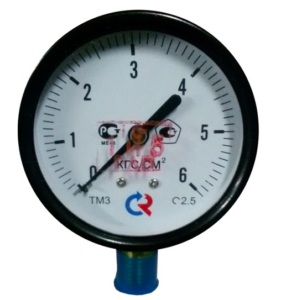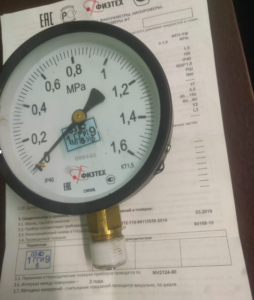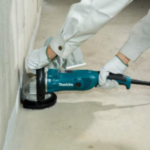Pressure gauge error and what is the accuracy class: how to choose
The error of a pressure gauge is determined by the percentage of inaccuracy, which sets the range of possible values. This percentage is always indicated in the description of the device in accordance with the requirements of regulatory documents. The article presents information about what accuracy classes exist and how the error can be determined.
The content of the article
Accuracy classes and redline
First of all, you need to understand what the accuracy class of a pressure gauge is. This is the name for the maximum error (in absolute values) that is allowed for a specific model. For example, if it is indicated that the device belongs to class 0.4, this means that the error is small (only 0.4%), and the pressure gauge scale is quite accurate.
If, for example, 4.0 is indicated, this means that the maximum permissible deviation is 10 times greater, which is noticeably a lot (4%). It is quite clear that the lower the value, the more accurate readings the equipment gives. The definition of all possible accuracy classes is introduced by GOST 2405-88. According to this regulatory document, 6 classes are distinguished:
- 0,4.
- 0,6.
- 1,0.
- 1,5.
- 2,5.
- 4,0.
Some sources provide additional values - 0.15 and 0.25. However, they are not presented in GOST itself.
The red line on the pressure gauge is also of practical importance. This is the name of the line that shows on the scale the maximum permissible pressure in the system. Those. This is a critical value, exceeding which can lead to emergency situations.The requirements for the red line on the pressure gauge require its presence in the factory version of the device or the installation of a separate metal plate that fits tightly to the glass.

Calculation of error by accuracy class
The rules for installing pressure gauges require independent determination of the error depending on the accuracy class indicated on the device. First of all, you need to know that the class is determined depending on the diameter of the device. The larger the diameter and the more scales, the smaller the errors. The already mentioned GOST 2405-88 provides a table defining 6 classes.
| Pressure gauge diameter | Accuracy class | |||||
| 0,4 | 0,6 | 1,0 | 1,5 | 2,5 | 4,0 | |
| 40 | — | — | — | — | + | + |
| 50 | — | — | — | — | + | + |
| 60 | — | — | + | + | + | + |
| 100 | — | — | + | + | + | — |
| 160 | — | + | + | + | + | — |
| 250 | + | + | + | + | — | — |
If you figure out how to select a pressure gauge based on operating pressure, you need to determine its maximum error by means of a simple calculation. This requires knowledge of the class value and the maximum measuring range. Moreover, where the red arrow is on the pressure gauge does not matter.
The calculation principle can be illustrated with an example. The device measures up to a maximum value of 10 MPa, and its accuracy class corresponds to 1.0. Accordingly, 10 * 1.0/100 = 0.1 MPa - this is the error. For example, if the scale shows 2.2 MPa, then due to inaccuracy, a deviation in the range of 2.1-2.3 MPa (but no more) may be observed. This is how a pressure gauge is selected based on operating pressure.
Based on this, we can say that 1.5 is an error of 1.5%. The limit value in the GOST 2405-88 classification is 2.5, i.e. error 2.5%. To choose the most accurate device, you should consider models with 0.4, i.e. with an error of 0.4%. For example, if the pressure gauge readings are 3.2, then its error does not exceed 0.4*3.2/100 = 0.013. Those. the true pressure value is in the range of 3.187-3.213 MPa.

Procedure for checking pressure gauges
Pressure gauges are marked from the factory, where the initial verification is carried out. Those. all new devices give accurate values with an error that does not exceed the specified range. The validity period of the initial verification is 1 or 2 years, depending on the specific model (the value is indicated in the device passport).
After this, the pressure gauge scale needs to be re-verified. The procedure is of great importance not so much for private houses, but for apartment buildings, as well as medical, educational and other organizations.
Re-verification is carried out only in a licensed company that has the appropriate permit. Moreover, in terms of cost, this service usually costs about the same as a new device, or even more. After completion, a stamp is placed on the pressure gauge - the next verification is carried out after the same period (i.e. 1 or 2 years).
Two conclusions follow from this:
- It is best to purchase a model whose factory verification is valid for 2 years.
- Before submitting the device for re-verification, it is worth considering the costs - it may be better to purchase a new model. For example, if there were hydraulic shocks, pulsations, or emergency situations in the heating system, then half of the devices do not pass verification. The pressure gauge readings must be quite accurate, so you have to purchase another model.

Please also note that the equipment must be operated under suitable conditions as described in the operating instructions. Typically, the device can withstand temperatures from -40 to +100 degrees, although it is better to keep it in a room with relatively warm air.
Now it’s clear how to calculate the pressure gauge error.To do this, they focus on the accuracy class and, depending on the specified value, determine the range of inaccuracy (from lower to higher values). If in doubt, you can install a new model for comparison or give the old one for verification.





